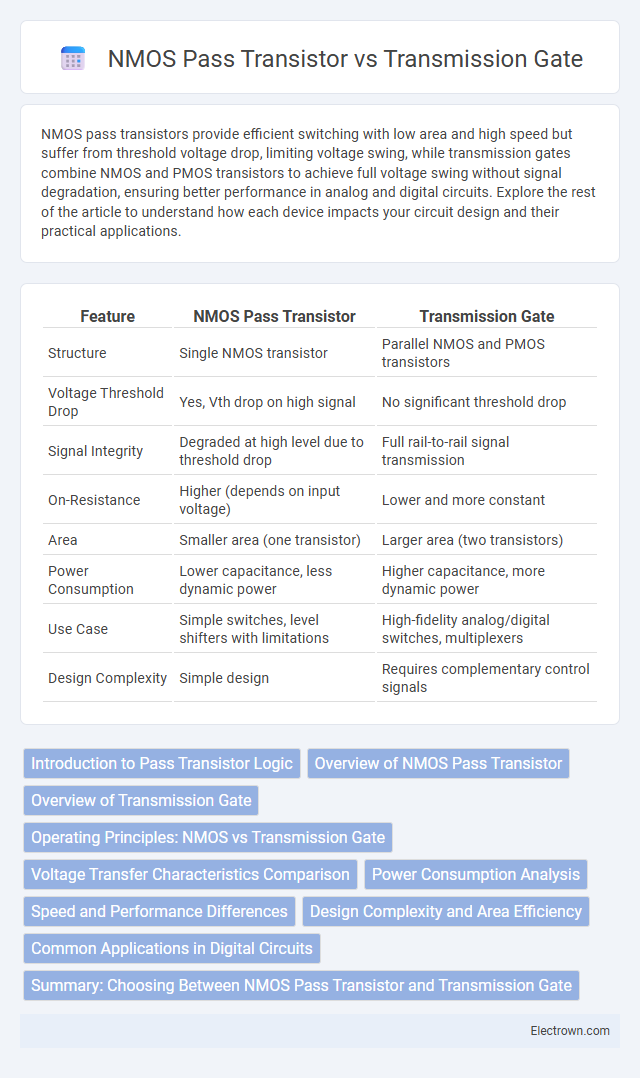NMOS pass transistors provide efficient switching with low area and high speed but suffer from threshold voltage drop, limiting voltage swing, while transmission gates combine NMOS and PMOS transistors to achieve full voltage swing without signal degradation, ensuring better performance in analog and digital circuits. Explore the rest of the article to understand how each device impacts your circuit design and their practical applications.
Table of Comparison
| Feature | NMOS Pass Transistor | Transmission Gate |
|---|---|---|
| Structure | Single NMOS transistor | Parallel NMOS and PMOS transistors |
| Voltage Threshold Drop | Yes, Vth drop on high signal | No significant threshold drop |
| Signal Integrity | Degraded at high level due to threshold drop | Full rail-to-rail signal transmission |
| On-Resistance | Higher (depends on input voltage) | Lower and more constant |
| Area | Smaller area (one transistor) | Larger area (two transistors) |
| Power Consumption | Lower capacitance, less dynamic power | Higher capacitance, more dynamic power |
| Use Case | Simple switches, level shifters with limitations | High-fidelity analog/digital switches, multiplexers |
| Design Complexity | Simple design | Requires complementary control signals |
Introduction to Pass Transistor Logic
NMOS pass transistors in pass transistor logic offer efficient signal transmission but suffer from threshold voltage drop, limiting output voltage swings and causing degraded noise margins. Transmission gates combine NMOS and PMOS transistors to eliminate the threshold voltage drop problem, providing full rail-to-rail voltage transfer and better signal integrity. This makes transmission gates more suitable for robust and low-power digital circuit design compared to single NMOS pass transistors.
Overview of NMOS Pass Transistor
NMOS pass transistors function as basic electronic switches allowing voltage signals to pass when activated by a control gate voltage, commonly employed in digital circuits for logic-level shifting and multiplexing. They exhibit a threshold voltage drop when passing a high logic level, causing signal degradation and limiting their use in full rail-to-rail voltage transmission. Your circuit design must account for this voltage drop, whereas transmission gates, combining NMOS and PMOS transistors, provide better signal integrity by minimizing voltage loss across the switch.
Overview of Transmission Gate
A transmission gate combines both NMOS and PMOS transistors to achieve a low-resistance bidirectional switch with minimal voltage drop, making it superior to an NMOS pass transistor alone. Unlike NMOS pass transistors, transmission gates effectively pass both strong logic high and low signals, reducing signal degradation and improving overall circuit performance. Your design benefits from transmission gates when precise voltage levels and efficient switching are critical in analog and digital applications.
Operating Principles: NMOS vs Transmission Gate
NMOS pass transistors operate by using an n-channel MOSFET to pass signals, but they suffer from threshold voltage drop, limiting their ability to pass a full logic high level. Transmission gates combine NMOS and PMOS transistors to create a bidirectional switch that passes both logic high and low levels without voltage degradation, enhancing signal integrity. Your circuit design can benefit from transmission gates when full voltage swing and low ON resistance are crucial for reliable performance.
Voltage Transfer Characteristics Comparison
NMOS pass transistors exhibit a voltage transfer characteristic with a threshold voltage drop, limiting the output voltage to approximately V_in - V_th, which can degrade signal integrity in high-level logic states. Transmission gates, composed of parallel NMOS and PMOS transistors, provide near-rail-to-rail voltage transfer by compensating for the NMOS threshold drop with the PMOS device, ensuring minimal signal degradation. Your circuit design benefits from using transmission gates when precise voltage levels and full-swing outputs are critical, especially in low-voltage CMOS technologies.
Power Consumption Analysis
NMOS pass transistors exhibit lower area and capacitance but suffer higher voltage drop and increased static power consumption due to leakage current when used as switches. Transmission gates, which combine NMOS and PMOS transistors, achieve near-ideal voltage transfer and significantly reduce leakage power, leading to improved power efficiency especially in low-voltage applications. Your choice between NMOS pass transistors and transmission gates directly impacts overall power consumption and circuit performance in digital designs.
Speed and Performance Differences
NMOS pass transistors exhibit faster switching speeds due to lower parasitic capacitance but suffer from threshold voltage drop, degrading signal integrity and performance at lower voltages. Transmission gates, combining NMOS and PMOS transistors, eliminate this voltage drop, enabling better full-swing voltage levels and improved signal quality, which enhances circuit reliability despite slightly higher propagation delay. Your choice depends on balancing speed requirements against signal distortion tolerance in high-performance digital designs.
Design Complexity and Area Efficiency
NMOS pass transistors feature simpler design and smaller area requirements compared to transmission gates, which consist of both NMOS and PMOS transistors. Transmission gates provide better signal integrity by avoiding threshold voltage drops but result in increased layout complexity and larger silicon area. Your choice between the two impacts overall chip area and design time, with NMOS pass transistors favoring compact designs and transmission gates suited for high-performance applications.
Common Applications in Digital Circuits
NMOS pass transistors are commonly used in digital circuits for simple switching and level shifting applications due to their reduced transistor count and faster speed. Transmission gates, comprising both NMOS and PMOS transistors, excel in multiplexers, flip-flops, and analog switches by providing full rail-to-rail voltage swing and minimal signal degradation. Your choice between these depends on the required signal integrity and complexity of the digital circuit.
Summary: Choosing Between NMOS Pass Transistor and Transmission Gate
NMOS pass transistors offer simpler design and smaller area but suffer from threshold voltage drop, limiting their use in low-voltage circuits. Transmission gates combine NMOS and PMOS transistors, providing full voltage swing and better signal integrity ideal for analog switches and multiplexers. Selecting between them depends on trade-offs in voltage levels, signal fidelity, and circuit complexity.
NMOS pass transistor vs transmission gate Infographic

 electrown.com
electrown.com